Whether you want the classic shop sign, glass painting or whatever these case histories will make an interesting read and set your mind at rest about the integrity of our project management and sign service quality.
Contact Nick @: Londonsignwriter@yahoo.co.uk traditional-signwriter-
CASE: Ted Baker – Knightsbridge Store
Working with TB graphic design ace Barry Wylie the project started with a CAD sketch of a banner and some nice mood swatches showing the vintage theme.
I saw immediately that Barry was passionate about this banner and let him know he could free flow any or as many ideas as he liked in order to fully develop this visual mural. Communication is everything.
After some exchanges we actually had the 2 banners coming together quite quickly.
Banner 1 visual – 7m
Spiral banner 2 – Custom font design
For the spiral I had Elisa Massari produce a ACad 3D layout that worked as a template enabling me to wind the banner drawing around the 45cm dia column which formed the centre piece.
Work on site took around 4 days to complete and again the TB fit-out team were on form and it was a pleasure getting into this work.
I also had some fun making a nice distress finish to the pillar which added a richness.
Important was that Barry dropped in at crucial points to just cast an eye over the lay ups and really the painting was a process of layers which followed the patter of how the visuals were made in Photoshop: Layer 1: banner panel, 2. edge, 3. scrolls, foliage, lettering and shade etc. That is why working on the CAD design and planning is so important because it familiarises on all points and allows you to make good progress where you need it… on site.
The final artwork looked really impressive.
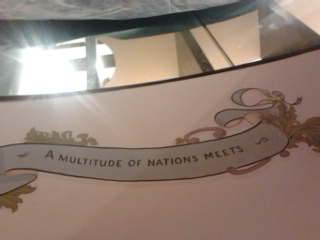 Gallery Ted Baker
Gallery Ted Baker
The new Sylvanian Families shop sign – by NGS
The Sylvanian shop sign required careful design adjustment in order to incorporate the new subtle 3d painted logo.
The outlines needed to enclose the title – and we wanted the largest possible font size and so we juggled the existing version and trimmed the ‘Y’ to fit.
A 4 coat base and 2 coat lettering + high-lighting and shade.
A great final product we think!
POD Organic Health Food outlet eatery – WC2
traditional-signwriter-
Created triple fascia lettering in organic paint and carried logo onto glass roundel.
Glass panel required 6 coats.
2 base green
1 pale green/white letter fill and back up
2 more back-up coats shade darker Pantone 566m
Varnish and pencil varnish… see below
Contact Nick @: Londonsignwriter@yahoo.co.uk
Diary of a gilding fix – Chelsea
April 2012
I met up with a small childrens’ outfitter in Chelsea after seeing their silver leaf lettering literally go to rust in a matter of months.
It seems the previous writer (name withheld) forgot to mention that so called silver leaf was infact a cheap tin interior variety…
The fix requires me to re-letter in 23ct white gold or platinum leaf.
The shop also wants a small motif projecting sign which needs to be made by laser cutter and out of a steel plate which will rust… in this situ ironically (boom, boom) the precise and desired effect.
Wanted originally as a hanging panel I decided to flip the format and created a ‘plinth’ bracket to which the client response came… I Like!
Contact Us @: Londonsignwriter@yahoo.co.uk
Diary of a huge Mural project – Damien Hirst: TRINITY Room, The Tate Modern 2012
Nov 2011 – March 2012
Trudging through the back streets of Peckham didn’t seem to be the fine art highway I had expected when I took on this covert project for Science Ltd of London. It really was Only Fools and Horses territory. At first glance the email seemed to suggest this was a specialised operation: a very large sign mural was needed… it had a multitude of straight lines and needed to be executed, and I quote… perfectly.
In the February gloom, mid-Monday afternoon I rounded the corner and saw a new smartly bricked industrial estate boasting a dozen or so workshops, tagged with 180cm avant garde numerals, as you’d kinda expect, and bright clean and tidy steel shutters… nothing looked bright and clean in Peckham so it was all quite weird..
I was ushered in and required to sign a confidentiality agreement. Then we entered what can only be described as a fine art factory. A beautiful one at that. Around the first 100 square meter studio area were several canvases and artists applying colours and intricate layers of some kind.
My task this day was to create the perfect sample. One square meter of enlarged graph paper as a graphic mural, directly onto the studio and later that month, all being well, the gallery wall. The gallery was to be the Tate Modern, London.
.Above: The first decent sample – Courtesy of Remi, me and Frogtape
CHOPPING WOOD – CLIMB THE MOUNTAIN
This journey actually started high up in the mountains of Italy, where I live with my wife Caterina and 3 daughters. An email arrived in late November asking for this strange obscure artwork to be quoted.
The design would total approximately 100 square meters and occupy 4 walls of the massive 3rd floor exhibition area of the Tate. The head of exhibitions for Science Ltd set out the requirements in concise terms. Perfect, perfect and more perfect.
Immediately I whirled about how to apply such a design, 4 meters by 8 apiece. What would be the methodology, how could I guarantee perfection, who would comprise my team, what would be the hurdles and challenges. It was a long list.
Cassia is an 11th Century village in the heart of the Apennines on the Tuscan hinterlands and in early December occupied by us and 10 others. The snow was due and it drifted in to about half a meter in one night. The fire was hot and my mind ached with central London and Damien Hirst.
My career as signwriter started in 1981 and filled itself with pub signs pausing after 10 years until October 2011. For some inexplicable reason I fancied climbing up the ladder again!
It’s easy to explain really having spent too long as product designer in front of the computer. I wanted it real again. This certainly was just that… and some way unreal as well sat up a mountain talking to Soho.
What struck me immediately about Debbie my contact at Science was the high level of communication used to set out the project. I didn’t want for information at this stage whether at 10 in the evening or six in the morning, she was at the email creating the information flow that would define what was needed and not.
8 emails came my way from the design office of Science in December and 33 in January as the stakes upped.
The graph design was being set out in Adobe Illustrator by her designers as we spoke and the crucial information regarding weight of lines was still to come. AutoCAD was the software I would have chosen and offered our in-house architect to produce all layouts.
… 5mm I think is the line weight with heavier borders… She said
I slumped back getting my head around 2km of 5mm lines to be rendered perfectly.
Assuming the wall surface would be pretty rough with its 12 years of history upon it I knew masking tape was out for 5mm lines.
Debbie stated it was done before in a show in New York a decade previously and it seemed to have been painted by hand. Could I really make all this happen with a poultry lining brush?
The timeslot was confirmed as just 8 days on site. Things needed to get better.
For some inexplicable reason I grabbed one of my kids’ felt tipped markers and set out a grid in pen on a spare mdf art panel. Fine tuning the edges by brush and woah the result was super clean and quick. Wow!… had I got this down in one single swipe?!
I would need to control the TM on this by making a series of fool proof studio samples. By elimination I went through the production options. Masking vinyl posed risks with bleeds and tearing the wall surface. Mask tape again was too unpredictable, quality issues persisted and time consuming – no way. Vinyl was ruled out by the client along with wallpaper… it had to be painted by hand… to look like print. Could it be a marker and fine tune solution… ingenious and quick!
The dimensions arrived early December and to my relief the weights were 25mm with 50mm borders.
I stayed with the pen struck edges and a one-stroke fill. That’s it! Fast clean efficient and manageable.
My first studio sample came through 95% clean. The sole problem was matching exactly the colour of fill to ink edge. That remained the task of my first visit to Science studios. I tracked down high spec rulers with 2mm surface offset, central handles and applied some neat non-slip pads. In Italy such tools are standard kit and come reasonably priced in Obi, a B&Q type of hardware store.
. Contact Nick @: Londonsignwriter@yahoo.co.uk
LONDON – TESTING TIMES
So things were looking good as I surveyed the wall and dropped my sample making gear off in the studio awaiting the arrival of Julian Brown (163) my long standing right hand man for these types of projects.
Julian was rock solid as usual on this project and has a career as display director for large balloon marketing operators and turned out the Wembley Stadium sized Virgin Atlantic balloon in a mean 5 days.
Briefing Julian was fairly straight forward because of the 163 factor (his Mensa IQ) and the warm freshly plotted drawing measured up perfectly. He liked big jobs and this one certainly measured up.
The first job today was to trim out marker ports from the layout so that the drawing acted as a ‘key-line’ guide: no carbon paper or chalk trace-off for this job as the Dulux Brilliant White matt wall surface needed to remain spotless. How happy I was that the Tate would be using Dulux, as it has sweet membrane surface and some extra flow medium added for a smooth finish. All valuable help in the big picture.
The drawing marked out and ruler in hand I started to strike in the marker lines.
We used the Tria Letraset marker B37 colour blue and though itself an uphill task supplying the 50 pens needed for the whole project the fresh nib flowed sweetly across the wall.
Nerves kicked in.
I used my breathing to control the tremor.
It wasn’t perfect yet.
There were wall surface undulations that caused stark tonal variations.
I felt the tension rise in my chest and neck. I didn’t want this… I didn’t want this to be happening.
I really wanted just a little piece of perfection...!
With the grid marker drawing set out I started to mix the opaque paint, Pelican casein Plaka that I had been recommended, but to my horror it mixed up seriously dull compared to the glowing pen and Pantone match-up swatch. ‘Able to work under pressure’ … my CV ran through my mind… my heart sank. The blue needed to be much brighter, matching the elusive luminous mid tone of the Tria B37 marker. But the marker itself was showing an ever widening range of variations… as they characteristically do.
Oh shhhhit!!…. This was absolutely NOT where I wanted to be heading.
2 serious problems now.
Firstly the softer tonal characteristic edge and secondly a dull colour match.
I added spectrum blue from my art bag and fortunately the colour boosted up to within a whisper of the bold original we chased.
John Harking was the art studio manager whom I needed to impress and after a few seconds of meeting John I knew he was to be my biggest challenge. Straight talking and uncompromising … there were no shades of grey with John.
And John had entered the room.
‘Let me know when you have something for me to see…’ came his soft Dundee accent, meaning that what he saw at a distance was not what he had in mind. It was not what we had in mind either… but I pressed on cutting in with ‘opaque’ blue , one-stroke and completing the grid.
Stepping back it wasn’t too bad.
It was clean. But then there were those occasional soft edges. I trimmed in.
‘This is pants Julian…’ I said dryly – the pens had 100% failed.
An hour later Julian and I had 2 pints of Wandle Best Bitter on the table and a series of vernaculars littering the place shaming even the most hardened Peckham clientèle a-sipping at the bar.
I don’t like trashing products but even the opaque had failed to cover… and the pens were history.
We had a grid with edges that were fluffy, solids that were thin, colour dull, even the base coat turned out to be artists gesso (not my beloved Dulux) and only the trace-off process met with success.
‘How the hell am I going to cut this in perfect Jules? Jeeze I need this to work here!’
Jules turned his pint glass… he’d seen this all before when we worked on cutting edge paint finishes together for interior design queen Tricia Guild in the nineties.
‘It’s a total mosh Jules…!’
‘The main point is the coverage issue’ He said.
We knew we couldn’t make it cover solid and the TM per meter was already well over an hour. That meant we had at least to achieve 1.5 hrs per meter to get to 150 hours to have the grids all done in one week. This needed 5 people on the work.
‘Nick! Got it!…’
‘Tell me!’
‘2 coats!… one slash coat and one over coat.. job done!’
163 was right.
Next day I went back into the studio and double coated. I’d got Johnson’s matt emulsion and colour mixed the blue spot on and it was all going from a total fail to looking 98% the good. John Harking had other ideas.
‘I don’t like these edges can you get these edges sharper?’
The other thing I decided in the pub the night before was to ditch the penned edge.
Another sample was now needed. The second sample was set out in a quick-fire 20 minutes.
Contrary to everything I expected, I was using masking tape on this bloody project! A complete 360 from my first envisage. Now that this was a masking tape job… cue my buddy fellow signwriter John Pope, another central figure behind this project.
Julian mentioned cutting whole squares in masking tape somehow… and was pushing using a rad roller (I had my doubts), and John had described how to make crappy masking tape create the perfect printed edge… the perfect printed edge?… my doubts persisted – how could I believe that? I had no choice and trusted these boys – and glad I am that I did.
Strimming in the masking tape much quicker this tie round, I started to trim out the over laps, forming up the final grid for painting. This felt better… nay good!
Popey had told me by over-painting the masking tape with (white) background colour it sealed all the ‘spider-leg’ leaks … then by applying the blue top coat, the tape would peel off leaving silk screen perfect edges. That was his story borne of success.
I struggled to believe this heavenly gift, so with doubt and fear now set aside I did exactly what John suggested.
Peeling off the tape revealed an exquisitely sharp blue grid. Bold colour and so so nearly perfect!
I was delighted. John Pope was right.
Above: Remi trimming the FrogTape crossovers – but the accuracy and time factor finally ruled out this process.
However 2 niggling fails persisted.
The trim cuts (weeding) had to be exact and the masking tape was so pale it would be virtually impossible to secure 100% accuracy and success over the thousands of cubes. Secondly the paint still needed snagging with minor second coats to sort this problem. And there were still a few leaks… but all said even John Harking was moved within a whisker of accepting this second sample.
‘Can ye get rid of these tiny trim errors?’
These were virtually impossible to eradicate – I knew that.
‘Yep no problem… these will be snagged out…’
.
ON THE ROCKS
On returning to my mountain I set up my team of 4.
I had met artist Remi Rough on Facebook and loved his sharp work. I had no idea where he lived on the planet but contacted him.
Remi, I said, there is a sample needed in a place called Peckham in South London United Kingdom… then we have to make a large mural at the Tate Modern… think Sharks and you’ll know who it’s for…. where are you based? Where do you live?
His reply came back immediately.
PECKHAM…
How about that! I had my main second in charge sorted!
.
MONKS AND POPES
The emails continued thick and fast and I decided to survey the Tate walls and set up a final 4 meter sample paint at the Science Studio.
Tate Modern Head Curator Phil Monk met me and we ascended into the enormous empty level 3 gallery. The oak floors absorbed the acoustics of our footsteps as we passed full height windows and St Paul’s across the water.
Phil seemed a nice bloke but we stayed in formal remit. The wall surfaces were orange peeled but not as bad as I had feared. The mural should paint ok on this I felt. Phil informed me that we could have 14 days access which for me made the whole project guaranteed success. With 14 days we could do anything!
‘How many of you working here..?’
‘4 in all’ I went on to outline my guys.
‘Sounds like a really good team there… Still think they should’ve done this in wallpaper!’ Phil muttered utterly bemused. We clicked.
I headed straight back to the Peckham studio to meet Remi and Julian for the final sample push.
The 1m x 4m CAD layout was first to be trimmed with marker ports. I had one final colour check to do and a 1m grid to set out while they cut. Working as production manager in China gave me the heads-up on the mechanics of production flow.
This project was technical yet prone to fatigue errors. I needed to be absolutely sure of two things today. Firstly the impact of errors due to precision fatigue and total time motion for 1x4m section ie: one quarter of a wall layout. Now I had dropped the penned method, the time and motion of the new masking tape process would change everything… so everything was by the clock.
I had to prepare myself for the studio manager who was now coming under some pressure. My job was to give him as easy journey as possible and instil confidence.
‘John, this sample today is all about process… that will create the quality and timescale… of course I can produce a perfect sample… but unless I can double check the process the timeline could blow out’.
John today had fewer words than ever it seemed. His butterfly wing paintings were behind and the distractions of the day mounted.
As I set out the original 1m x 1m drawing John spoke out as I marked out the wall with the 4m drawing.
‘N’ya can’t use that older version drawing they’ve all been changed…!’
What the!?? He was gone…
I quickly went over the new 4 meter drawing and yes the internal cube dimension was now 168mm x 170mm.
‘It should be 170 x 170 John!’
Shit had hit the sample wall!
After 20 minutes the CAD tech arrived and confirmed the 4m drawing was a dud – Adobe Illustrator had failed.
No problem. We moved on with what we had… a good 1m section.
We set out 2 panels in 25 minutes and test ran a great product on Remi’s recommendation. Enter the now famous FrogTape!
This green tape claimed to be leak proof and 100% clean low tack tear off.
We tested and it was a great success… save for the price.
This sample was also about test running new flat steel rulers for solving the fine trim edges that persisted in the last sample.
Remi was the man for this process and brought the sample to about 98.5% perfect.
‘I can still see these tiny errors… much better but this is no good and this and this…’ Mr. Harking left the room.
Remi was stunned. The finish was visually perfect at 3 feet. Harking wanted it perfect at 3 inches.
So did I.
With 24mm green Frogtape we were laying out the horizontals then the verticals and fine trimming out the cross-over waste. The trim had to be absolutely 1000% perfect. Otherwise we had to fine cut in 0.03mm high build errors which was virtually impossible.
This also added time because each grid ‘cube’ required 8 perfect trim cuts.
We had come very close and this was the final yet crux of the whole project.
We headed off on our trains heads whirring with the days highs and lows.
… Julian’s Cube mask idea, Johns sound painting technique, Remi’s fabulous skills… we needed to find a super uber final solution.
Pulling out of Peckham Rye station I texted Jules… I’VE GOT IT!!!
.
THE ITALIAN JOB
Elisa Massari is good friend, great designer and AutoCAD specialist based in Piacenza Italy – Elisa was our 4th team member and was about to do a truly fantastic job.
We flew into London Stansted together and met Julian in Victoria for an eat and greet.
‘Jules… this is the final masking trim solution!’ I immediately started and told him just how we would nail it.
‘Yep I think it will work if we use rollers…’
‘I want to use brushes… easier to control..’ 163 sipped his beer unconvinced.
‘Jules you can use rad rollers no problem.. I prefer brushes that’s all’
.
DAY ONE
The first task having set up our towers was to trim out the drawings and draw up the largest mural on the South wall. Jules and Elisa trimmed out. Remi and I built towers and marked up the spirit level start point on the wall.
With two towers abreast we decided (inexplicably) to use the 4m drops horizontally and grid out 4m x 4m in one hit with Remi and I on top level while Jules and Elisa covered the lower half.
The walls were out. They looked like plaster but were actually MDF constructed erected on alloy frames. They dipped and buckled causing the horizontal layout to float and liquefy almost across the uneven surface. Our first mark-out had wanders of up to 4mm.
This wall was the first learning curve. The printed drawing was absolutely perfect yet the walls caused it to meander. But was it perfect? We realised the heat of the plotter could distort the paper by a millimetre or two across short distances. Our marking to the line had to be even tighter – spot on. We also needed to double check all the suspected wanders with spirit levels.
After the first 4m x 4m section was marked out we decided to revert to using the drawings as first intended as vertical drops. The errors diminished as gravity assisted. Things were getting very much better.
I adapted rulers… and kept thinking the methodology through.
After the first morning we had got to 1pm with one wall marked out. Good stuff had happened and a few minor bad things too… but I was stressed and transfixed with what I now had to do. Prove the system I thought of on the 6.15 out of Peckham 3 weeks before would work.
Yep fact was it still hadn’t been done and dusted! A 98% success was not good enough for the staff of Damien Hirst and now it seemed only +100% was good enough for us.
I had bought 24 rolls of extra wide 100mm masking tape. Here’s why… let’s think cubes not grids.
By masking to the left boundary of the vertical grid (or the inner left half of the cube), the tape occupied 100mm of the internal cube. Then by masking the right side, it overlapped and occupied the full aperture of the 170mm cube – overlapping by 30mm in the centre.
By masking the full 4m drop in one hit the cubes were completely set out in ‘columns’.
This was done with me at top, lining up and the team pulling the roll to the bottom with the tape lining up automatically to the vertical markers.
This was then ‘tapped’ and rubber bladed in flat.
Then the 170mm wide ‘columns’ needed to be cut horizontally forming our 170mm cubes.
Whereas the 24mm tape required 8 fiddly corner trim cuts, this system required one full cut across the top and bottom in order to complete the masked cubes and by default form the perfect grid lines.
8 impossibly fiddly cuts became 2 perfect slices and the infamous trim errors became history!
The real plus was labour time came within the golden 90 minutes per metre.
Above: Remi lines up the columns of tape, freshly sliced, ready for paint
That concept was what I hatched and texted to Julian on the 6.15 out of Peckham Rye but would it work at 1.15 on Platform one at Tate Modern!? If it worked it would be the solution to everything!
As I prepared the test section on the top 5m scaffold tower, completing the very first blue coat overlay, the team stood back down below.
We watched the paint dry… finally at 1.45 I picked the cube centre seam and peeled it at 30 degree oblique angle. Then the other half to complete the reveal.
Turning to the crew below I said just one word.
‘Fookinperfect!!’
.
BLUE SKIES!
The first wall was completed in under 3 days. The pace picked up and 3 walls were dusted off in five.
This was exceeding our TM expectations.
A good job too because there was a fair bit of snagging from the first wall and we needed to revise the blue coat technique… most tiny bleeds were on the horizontals due to moisture build-up… and yes Jules was right – rollers were the first order. By dry mist coating the blue on all the tetchy horizontal areas we eradicated the errors by 90%… 5 mist coats were needed however.
A SNAG ABOUT SNAGGING
The walls were pretty rough and the Dulux never arrived – instead the painters had used cheap tosh which kept us busy for 5 days tough snagging because the cheaper paint has rough surface membrane and combined with the orange peel wall surface we could never eradication 100% errors. We estimated 3 days for snagging and 2 days for getting a few jars in at the Founders Arms next door.
Remi had to be on his Kings Cross mural by day 6 and Elisa home by day 7.
Jules and I were going it solo with one wall to do, all the freehand writing and the snagging.
We had the final East wall done in a sharp 2.5 days just the two of us and it was 99% snag free. Not because we are ‘dream team 163’ but because we had outgrown the stress , got used to the fatigue and plain gotten pretty good at it. Methodology and practice is oil to the machine.
Phil Monk was consistent in offering support along with his assistant Kerstin (my boyfriend’s a signwriter too...)
The whole Science team were superb. And we love Damien Hirst!
For the last 3 days I was flat on my face signwriting 120mm Helvetica Light tag lines at 115mm off the floor which was a killer.
Debbie arrived with Ollie the installation manager on second last day but flat out on the deck our first and final meeting was rather too short…in every respect!
But the extra 3 days snagging nearly pushed us over.
HARKING ON – SIGNING OFF
John Harking arrived at Tate as planned on our last working day, Sunday March 4.
Due in the room at 3pm for final check (I don’t want to see more than 5 errors…!) there was no sign of him. Jules and I were too busy to care, desperately behind on the final eye-level snag through.
Frog tape in hand I tasked Julian to find me just 5 errors a-wall and tick tape them while I chased his tail.
3.15: No John Harking…
‘Jules give me another 5 errors! All way around!!’
We couldn’t find them… nor could John when he arrived at 3.26
‘Bloody security kept me locked out for 26 flippin minutes…!’
Standing in and standing back Mr. Harking finally turned.
‘You knuw it looks greyt dunyou?!’
Chanel 4 featured Damien Hirst – 10min 30 seconds
Contact Us @: Londonsignwriter@yahoo.co.uk
Nick Garrett
NGS
 articles
articles
- Watch | Damien Hirst on Damien Hirst at Tate Modern (selectism.com)
- Sylvanian Families sign finished today – NGS (londonsignwriter.wordpress.com)









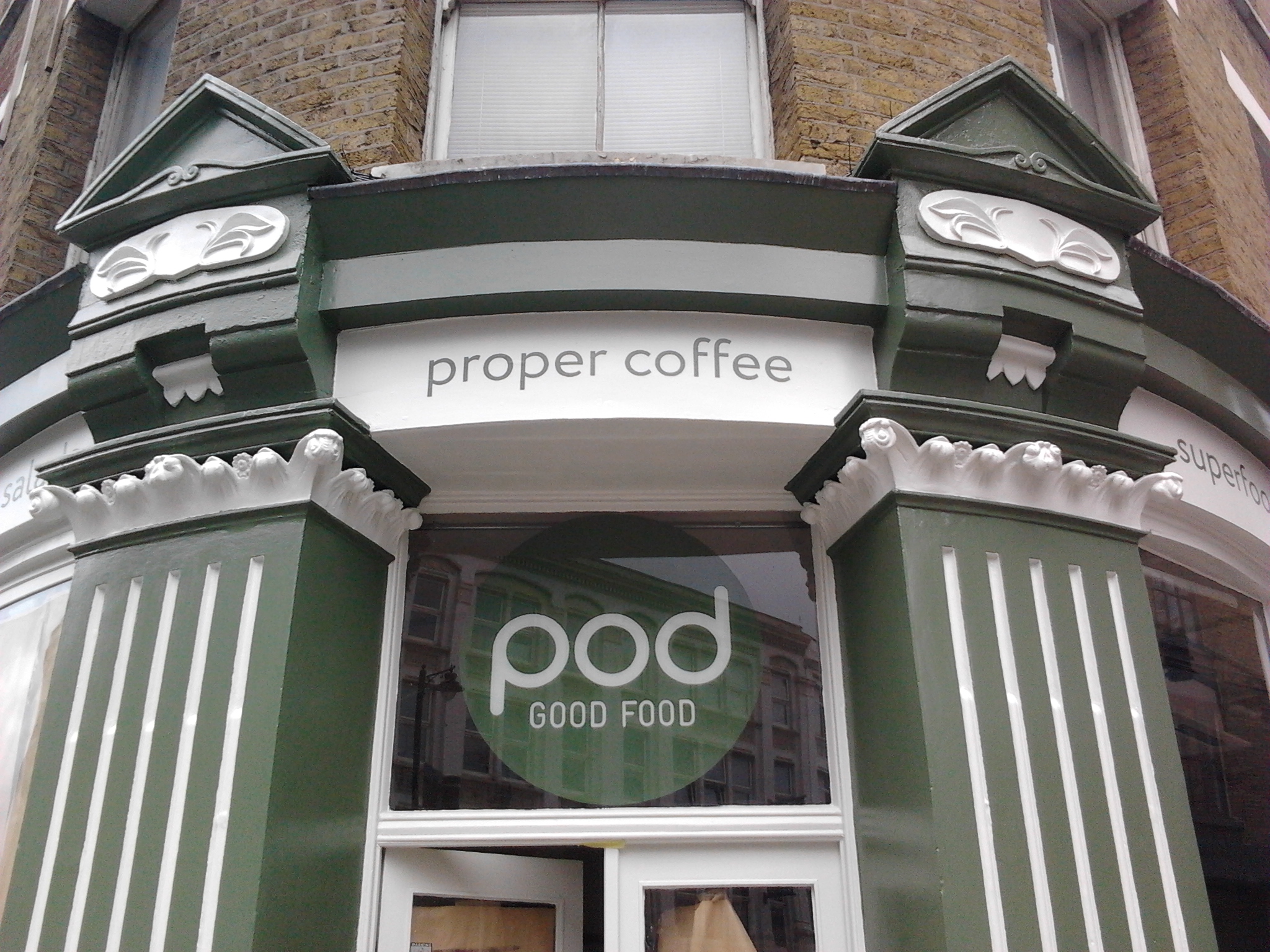







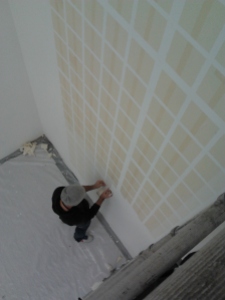




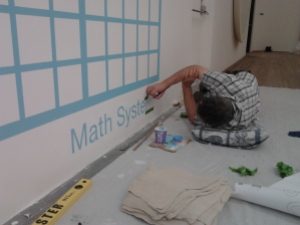


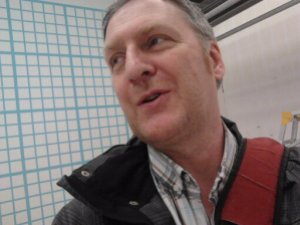


12 Comments
Comments are closed.